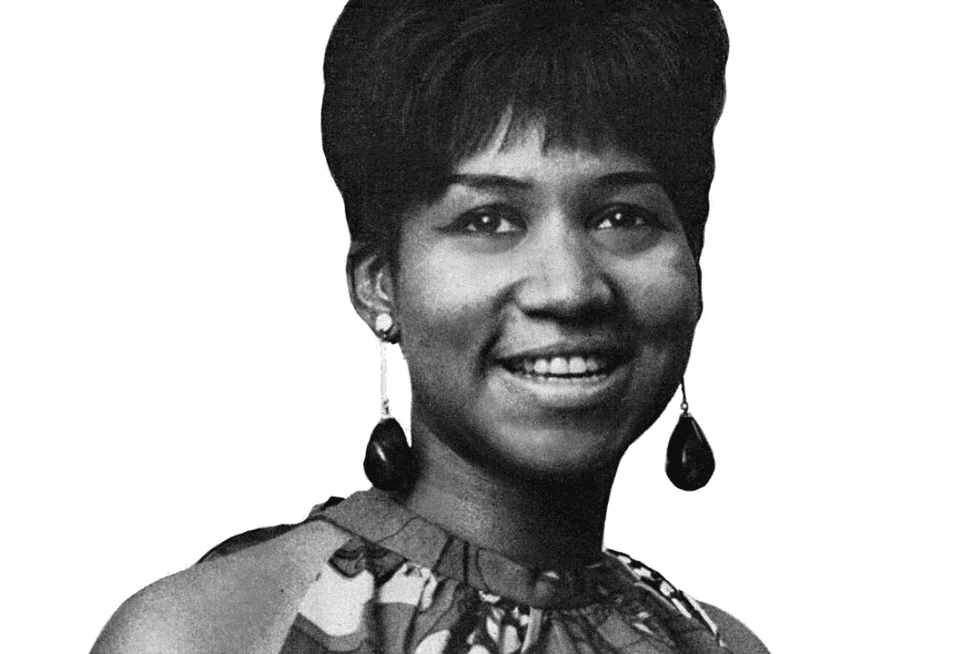

Aretha Is Feelin’ Good Again
“Rock Steady” is a song about nothing. The emblematic song on what I consider Aretha’s last great studio album, Young, Gifted and Black, it is at most one in a long line of hits that either introduce or exploit the latest dance: Chubby Checkers’ “The Twist”, of course; Dee Dee Sharp’s “Mashed Potato”, Little Eva’s “Loco-Motion”, the Capitols’ “Cool Jerk” and a few thousand others. Only there was never a dance called the Rock Steady. The closest we get is Aretha’s order to “move your hips with a feeling from side to side/Sit yourself down in your car and take a ride.” (Hard to do the latest dance craze sitting behind the wheel.) “Rock Steady” just is. What it is (what it is) is a celebration of Blackness. And was received as such—in the hot summer of 1971, Boston ghetto kids ran around shouting “Roxbury baby!”
The cover photograph of Young, Gifted and Black shows Aretha, sans makeup as on Spirit in the Dark, in a dashiki and turban, standing in front of a stained-glass window: two aspects of the heritage that Aretha was now owning. “Rock Steady” is the carnal side of the Aretha who sings the churchy title song.
“Rock Steady” was cut at the second Young, Gifted and Black session, on 16 February 1971 at Criteria in Miami. For whatever reason, the musicians, including Aretha, stayed in one hotel, Wexler, Mardin, and Gene Paul, a new engineer sitting in for Dowd, in another. One car picked up the musicians, another the production staff. This morning, the producers were an hour late getting to the studio, so the players and Aretha had time on their hands.
“Aretha sat down and showed us all the songs she wrote,” says Chuck Rainey. Everyone liked ‘Rock Steady,’ so we made a rough cut. One take. Just something to work on later.”
As it turned out, they never changed a note. “When Jerry and them came in, they wanted to change things. They said like, ‘Let’s go to bar thirty-five and work on that.’ Now it starts to sound better ,because they’re producers. It happens a lot. The producer wants to work on something, put their touch on it. Whereas some things don’t need to be worked on. They’re already done. Jerry and them tried all morning, we made six or seven takes, everything they asked us to do, we did, but never got the feel of what we had already laid down. We were a family.”
Back in New York, Atlantic’s house arranger Arif Mardin dubbed in several others, including the Sweet Inspirations and the great Donny Hathaway’s organ, but it was at bottom the funky demo, cut while the grownups were away, that shot to #7.
“Rock Steady” was Aretha’s first wholehearted venture into a then-only-recently mainstream genre (i.e., it had been relegated to the R&B charts), until James Brown finally crossed over with the huge mid-’60s hits “Papa’s Got a Brand New Bag” and “I Got You (I Feel Good)”. It was the Godfather who brought the funk.
Funk flattened songs out harmonically, trading chordal richness for rhythmic complexity. Funk’s other innovation was to subdivide the basic pulse from eighth notes into 16th notes. Immediately, musicians had more beats to syncopate, hence more opportunities to kick dancers in the behind.
“Rock Steady” is a perfect example, with Dupree’s bob-and-weave rhythm guitar, Rainey’s bustling bass, including the Rainey Slide, and Purdie’s syncopated beat pulling you every which way but loose. The three players are entirely simpatico, with Purdie in the catbird’s seat, a good place for the bumptious, jovially self-aggrandizing drummer. For all of nine seconds, from 2:28 to 2:37 in “Rock Steady”, Purdie plays a famous four-bar solo that all but defines funk drumming. Nine seconds, that’s it. And one of Purdie’s funk drumming’s, finest moments.
And “Rock Steady” wafts away on the Sweet Inspirations’ whispered ghettospeak what it is what it is, the song floating off as ethereally as it started out funky.
Sources Cited:
“Atlantic Records Discography Project” complete online sessionography, 1947-2001 at jazzdisco.org.
Branch, Taylor. At Canaan’s Edge: America in the King Years 1965-68. Simon & Schuster. 2006.
Cohen, Aaron. Amazing Grace. Bloomsbury Academic. 2011.
Dobkin, Matt. I Never Loved a Man The Way Love You. St. Martins Griffin. 2004.
Guralnick, Peter. Sweet Soul Music: Rhythm and Blues and the Southern Dream of Freedom. Little Brown. 1986.
Heilbut, Anthony. The Gospel Sound. Simon & Schuster. 1971, updated 1997.
Joseph, Peniel. Stokely: A Life. Basic Civitas. 2014.
Ritz, David. Respect: The Life of Aretha Franklin. Back Bay/Little Brown. 2014.
Salvatore, Nick. Singing in a Strange Land: C.L. Franklin, The Black Gospel Church, and the Transformation of America. Little, Brown. 2005.
Scherman, Tony. “The Man With the Million-Dollar Voice” (profile of C.L. Franklin. The Believer. 1 July 2013.
——————. Interviews with Chuck Rainey, Summer 2020, and Jim Dickinson. March 1987.
Wexler, Jerry. The Jerry Wexler Collection (1967-2004), Southern Folklife Collection. Louis Round Wilson Special Collection Library. University of North Carolina, Chapel Hill.

